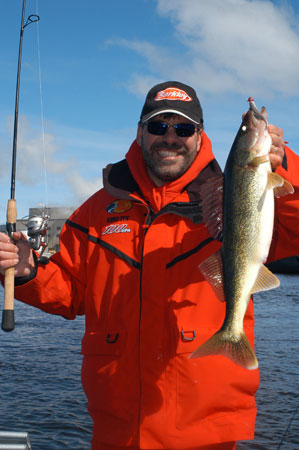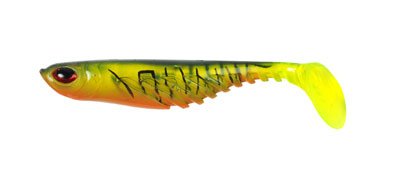While the basic jig dressed with a minnow has been the “spring walleye angler’s” go-to bait for decades, the modern walleye angler is trending toward using “artificial” dressings to their jig presentations. Some use the soft baits in conjunction with live bait, but more and more anglers are using them as substitutes for the real thing. Of course, they wouldn’t be trending that way if these new baits didn’t have some advantages, and of course, catch fish.
 Artificials tend to be more durable on the hook than live bait, so you save time not having to re-bait as often. That “stay on the hook” characteristic can occasionally even get you a “second chance” bite that you would not get if you were using live bait. Artificials come in a wide range of colors and actions, so you can better match the lure to the fishing situation at hand, like using a brighter color action tail in dingy water or a natural color, subtle action tail in clear water. So let’s look at some of the artificials that you should consider adding to your early season walleye arsenal.
Artificials tend to be more durable on the hook than live bait, so you save time not having to re-bait as often. That “stay on the hook” characteristic can occasionally even get you a “second chance” bite that you would not get if you were using live bait. Artificials come in a wide range of colors and actions, so you can better match the lure to the fishing situation at hand, like using a brighter color action tail in dingy water or a natural color, subtle action tail in clear water. So let’s look at some of the artificials that you should consider adding to your early season walleye arsenal.
For most early season vertical jigging scenarios, a subtle action tail will be your best choice. A bait like the Berkley PowerBait Minnow in the 2 or 3 inch sizes mimic a real minnow quite well in size and shape. We often will double up the baits, threading a 3 inch Minnow on the jig right up to the jighead, then hooking a 2 inch version through the nose. This tandem bait set-up is deadly at times because it increases the lure’s profile, adds a little extra action to the presentation, and in the event that a short strike results in the 2 inch Minnow being plucked off, you can quickly drop the bait back down to the fish, often resulting in a second strike that will hook the fish
A similar bait that can add even more scent appeal to the presentation is the Berkley GULP! Minnow. GULP! products are not soft plastic. Soft plastics like the PowerBait line are made with oil-based resins, where as GULP! is made with water-based resins. This allows for much more scent distribution since when scent is added to a bait created from oil-based resins, the oil literally traps the scent inside the bait. While some of the scent does get out, the oil is actually functioning as a barrier. Gulp!, on the other hand, disperses the water-soluble scent as soon as it hits the water because there is no oil barrier keeping the water out. This allows the bait to disperse scent almost like a blood trail, expanding the strike zone by attracting fish that do not see the bait. That’s why it is important to fish GULP! baits slowly and allow the bait to do what it is intended to do: disperse scent.
Subtle is not always the way to go however if you want to put more walleyes in the boat. There is a fast growing segment of artificial tails that add more attraction to the mix; the “action tails”. When walleyes are in a more aggressive mood, or when you want a presentation that moves a little faster, covers a little more water, but still isn’t quite as intense as throwing a crankbait, the action-tails fit the bill nicely. Another good situation for action tails is in the spring when you are dealing with rivers dirtied from rain and run-off. That little added action and the vibration it puts out can often help fish locate your offering easier.
 In some areas around “walleye world”, action tails have been used for a long time. On the upper reaches of the Mississippi River for instance, walleye anglers have long used a style of tail known as a “ring-worm”. Berkley’s version, the PowerBait Rib Worm, has all the characteristics that make this classic lure design so deadly; the 4 inch length that gives it a larger profile than most other walleye baits, the “ribbed” design that gives the body of the bait a very limber and undulating action especially when fished in current areas, it comes in a wide array of proven walleye-catching colors, and the small curl-tail that adds just the right amount of flutter on the retrieve to trigger bites from even the most weary walleye. The big advantage to the Rib Worm is it’s impregnated with Berkley’s PowerBait scent proven to increase a soft baits appeal. The Rib Worm is most often fished on a light jighead, 1 /16th to 1/8 ounce and pitched to current seams and eddies, or in the event of high water, it’s not unusual to see anglers pitching these to timber or similar flooded cover along the shore. It can also be fished effectively right along the river bottom, typically on a little heavier jig.
In some areas around “walleye world”, action tails have been used for a long time. On the upper reaches of the Mississippi River for instance, walleye anglers have long used a style of tail known as a “ring-worm”. Berkley’s version, the PowerBait Rib Worm, has all the characteristics that make this classic lure design so deadly; the 4 inch length that gives it a larger profile than most other walleye baits, the “ribbed” design that gives the body of the bait a very limber and undulating action especially when fished in current areas, it comes in a wide array of proven walleye-catching colors, and the small curl-tail that adds just the right amount of flutter on the retrieve to trigger bites from even the most weary walleye. The big advantage to the Rib Worm is it’s impregnated with Berkley’s PowerBait scent proven to increase a soft baits appeal. The Rib Worm is most often fished on a light jighead, 1 /16th to 1/8 ounce and pitched to current seams and eddies, or in the event of high water, it’s not unusual to see anglers pitching these to timber or similar flooded cover along the shore. It can also be fished effectively right along the river bottom, typically on a little heavier jig.

Another action tail that has fast become a favorite of ours in many situations is the Berkley PowerBait Ripple Shad in the 3 and 4 inch sizes. This minnow-like tail features a unique rippled body, which adds more vibration and swimming action (as well as giving the bait more surface area for dispersing scent), and a paddle-tail that sends out a lot of vibration as the lure is retrieved. The Ripple Shad for us has become a lure that we use almost like we would a mini-crankbait or small swim-bait, but with a jigging action rather than a steady retrieve. You want to make sure when you work this lure, you jig it in such a way as to make sure that paddle tail vibrates vigorously on the up-swing and flutters as it drops back down. Fish the Ripple Shad on a heavier jig than you would normally fish live bait, typically in the quarter to 3/8 ounce range. This will help you get the action needed to make the tail work the way you want it to.
Sure, there will probably always be those days on the water that nothing will trigger a walleye to bite quite as well as a well placed jig and minnow, but as lure manufacturers get better and better at creating soft plastics and artificial baits with the smells, tastes and actions that attract and trigger fish, there’s no doubt the use of artificial soft baits will increase the chances of you getting your Next Bite.










